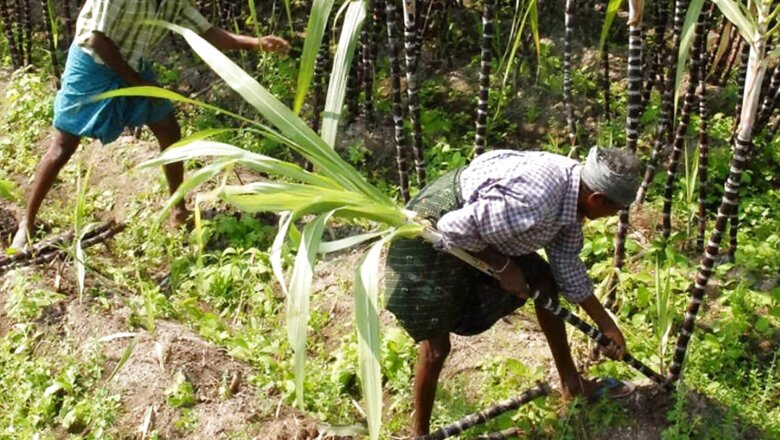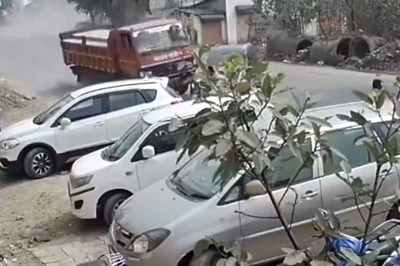
views
The writing on the wall is crystal clear. There is no scope for any complacency. It is the need of the hour to take care of small and marginal farmers on the ground, and not just politically. The latest National Sample Survey (NSS) report titled Land and Livestock Holdings of Households and Situation Assessment of Agricultural Households has reinforced the fact that farmers urgently need a cushion which catapults them towards wholesome financial empowerment as 87.5 per cent agricultural households have less than two hectares of land. It is an eye-opener as majority of farmers are into subsistence farming.
With less than two hectares of land, a rural household with four to six members cannot meet their basic needs with grace. The more they try to improve their condition by getting into tenant farming, they end up incurring huge debt. Punjab is a glaring case in point. There are multiple reports painting a grim scenario. In 2018, a joint study was conducted by Punjabi University, Patiala; Punjab Agriculture University (PAU), Ludhiana; and Guru Nanak Dev University, Amritsar, which said that between 2000 and 2015, nearly 16,606 farmers ended their lives. As per the report, 1,107 farmers who died every year by suicide in Punjab were marginal and small farmers.
The NSS report has pegged the percentage of indebted agricultural households at 52.2 per cent with an average amount of Rs 74,121 as an outstanding loan per agricultural household. The All India Debt and Investment Survey NSS 77th round (January-December 2019) report also says that the average amount of debt was Rs 59,748 among rural households—Rs 74,460 for cultivator households and Rs 40,432 for non-cultivator households. This leaves us with little scope to misread the writing on the wall. It will be disastrous if governments do not come forward with a blueprint to provide agricultural households with an additional financial cushion to ensure not only India’s food security but also safeguard agriculture and small farmers from near-disaster.
Revamp Rural Industrialisation
The recent NSS survey does not offer much space to be complacent. The average monthly income from different sources per agricultural household owning up to 2 hectares of land has been pegged at Rs 10,218 (July 2018-June 2019), which is too little to meet the basic needs of a household with a minimum of four members. Even a peon in a government office earns Rs 25,000 in a month.
ALSO READ | Liberalization Neglected Rural Growth for 30 Years. India Can No Longer Afford to Do That
As small farming is not so lucrative, younger generations do not want to follow in their parent’s footsteps, which pushes them to work in cities. Unfortunately, urban areas, while offering more opportunities, also relegate many to low-earning jobs. Working in cities, the earnings and expenses are at par for rural youth; their net earnings are almost negligible to help out their families residing in villages. So, it is not lucrative for them to work in cities far away from their native rural places. There is hope that promotion of new industrial investment with a special incentive for rural areas will provide new jobs to rural youth.
Farming is a seasonal affair. Besides part-time seasonal farming, a small farmer and a farm labourer have sufficient time to work and can earn Rs 12,000-Rs 15,000/month easily from working 8 hours in a nearby industry. This can ensure an additional income to minimise their dependency on agriculture-based income. This model of linking rural industrialisation with employment to small and marginal farmers and farm labourers can be amplified pan India. It would be the real execution of ‘Sab ka Saath, Sab ka Vikas’, covering more than 70 per cent of the population of the country residing in rural areas.
Before economic liberalisation in 1991, the central government preferred to issue conditional licenses and incentives to promote the industry in rural and backward areas only. After liberalisation, delicensing did away with the crucial aspect of locating industry in rural or distressed backward areas. In the last 30 years, industrial growth has shifted from rural and backward areas to crowded industrial hubs in developed cities.
Special incentives are being offered to develop industrial corridors and clusters but this model should be replicated in rural and backward areas to provide employment opportunities to the nearby small and marginal farmers and farm labourers.
The Way Ahead
The rural economy is the proverbial silver lining for the country. And it is time to act now. Those dependent on agriculture need to be provided with job options for the period when they do not have anything gainful to do. The traditional models of job generation have to be re-evaluated. A distributed, micro-level factory that can produce micro-enterprises has to be created and supported in rural areas. For instance, the processing and packaging of vegetables and fruits for sale in urban areas can be a micro-enterprise that may not need high capital investment but will be labour intensive at the block level in rural areas.
ALSO READ | Punjab’s K3P Programme a Holistic Initiative for a Sustainable Agriculture Sector
As a long-term solution, the government will have to revive cottage industries in rural areas at a mass scale. Co-operative societies, Farmer Produce Organizations (FPOs) and self-help groups (SHGs) can be of great utility provided a fine-tuned roadmap aligned to ground realities is followed. The new Central Cooperation Ministry can also be a catalyst to drive rural prosperity.
Rural households should be brought under the ambit of the Mahatma Gandhi National Rural Employment Guarantee Scheme (MGNREGS) so that they are paid when they carry out works in their fields during sowing and harvesting of their crops and other scheduled farm activities, like levelling of fields, or other allied activities including horticulture farming.
India is home to world’s largest rural population and we need to take care of the future generations. Mahatma Gandhi’s dream of a self-sufficient and self-reliant rural India can be fulfilled by providing job opportunities to small, marginal farmers and farm labourers in places close to their native villages. It is time for a policy and framework to promote Prime Minister Narendra Modi’s ‘Atmanirbhar’ philosophy of holistic development. Special incentives have to be provided for industrial investment in rural and backward areas to generate an additional scope of employment and income for the rural generation.
The author is Vice-Chairman, Punjab State Planning Board and Chairman, ASSOCHAM (Northern Council). The views expressed in this article are those of the author and do not represent the stand of this publication.
Read all the Latest News , Breaking News and Ukraine-Russia War Live Updates here.
















Comments
0 comment